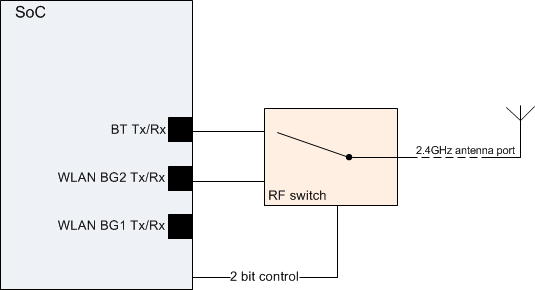SWRU423A July 2015 – May 2016 WL1801MOD , WL1805MOD , WL1807MOD , WL1831MOD , WL1835MOD , WL1837MOD
-
WiLink 8 WLAN Features Guide
- Trademarks
- 1 Introducion
- 2
General Features
- 2.1 Supported Rates
- 2.2 High-Throughput (HT) Features
- 2.3 Quality of Service (QoS)
- 2.4 Protection Types
- 2.5 Suspend and Resume
- 2.6 WoW (Wake on WLAN)
- 2.7 Set TX Power
- 2.8 5-GHz Antenna Diversity
- 2.9 Wi-Fi – Bluetooth/Bluetooth Smart Coexistence
- 2.10 Wi-Fi – ZigBee Coexistence
- 2.11 Accurate Synchronization Over Wi-Fi
- 3
Single Role: Station
- 3.1 Scanning
- 3.2 Connection
- 3.3 Disconnection
- 3.4 DHCP Client
- 3.5 Security
- 3.6 Filtering
- 3.7 Auto ARP
- 3.8 Preferred Networks (Profiles)
- 3.9 Power-Save Mode
- 3.10 Power-Save Delivery Protocols
- 3.11 Keep-Alive Mechanism
- 3.12 Smart Config
- 3.13 Regulatory Domain
- 3.14 DFS Slave (Channel Switch)
- 3.15 Roaming
- 4 Single Role: AP
- 5 Single Role: P2P
- 6 Single Role: Mesh
- 7 Multi-Role
- 8 Performance
- Revision History
2.9 Wi-Fi – Bluetooth/Bluetooth Smart Coexistence
Both WLAN and Bluetooth operate on a 2.4-GHz ISM band. Allowing the two technologies to work simultaneously, especially when located on the same device, is a challenging task that requires special treatment to keep performance quality on both sides. The advantage of having both Wi-Fi and Bluetooth/Bluetooth Smart on a single combo device such as WiLink8.0 provides better correlation between the different IPs to ensure good performance. WiLink8.0 uses a shared antenna for Wi-Fi and Bluetooth.
This operation is accomplished by managing a time-division multiplexing (TDM) scheme; transmitting and receiving independent signals over the shared antenna in an alternating pattern, using an external controlled switch.
The WLAN both switches the antenna to the Bluetooth IP and protects BT traffic from any WLAN traffic by other devices, using a number of different methods.
 Figure 4. Wi-Fi – Bluetooth/Bluetooth Smart Coexistence – Shared Antenna
Figure 4. Wi-Fi – Bluetooth/Bluetooth Smart Coexistence – Shared Antenna